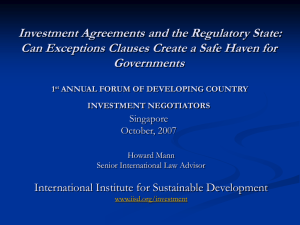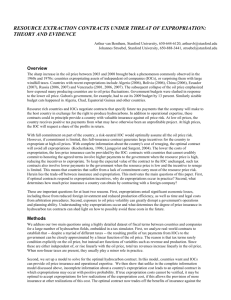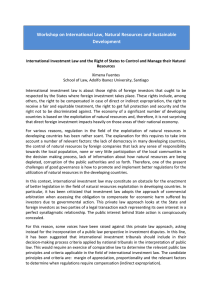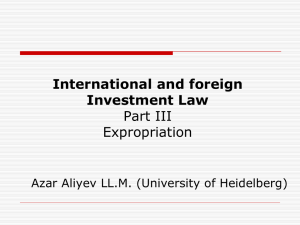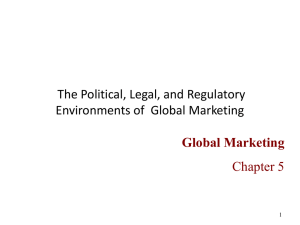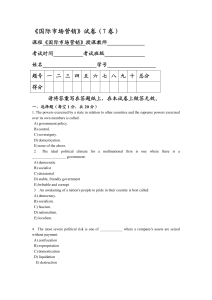PRICE OR POLITICS? AN INVESTIGATION OF THE CAUSES OF EXPROPRIATION
advertisement
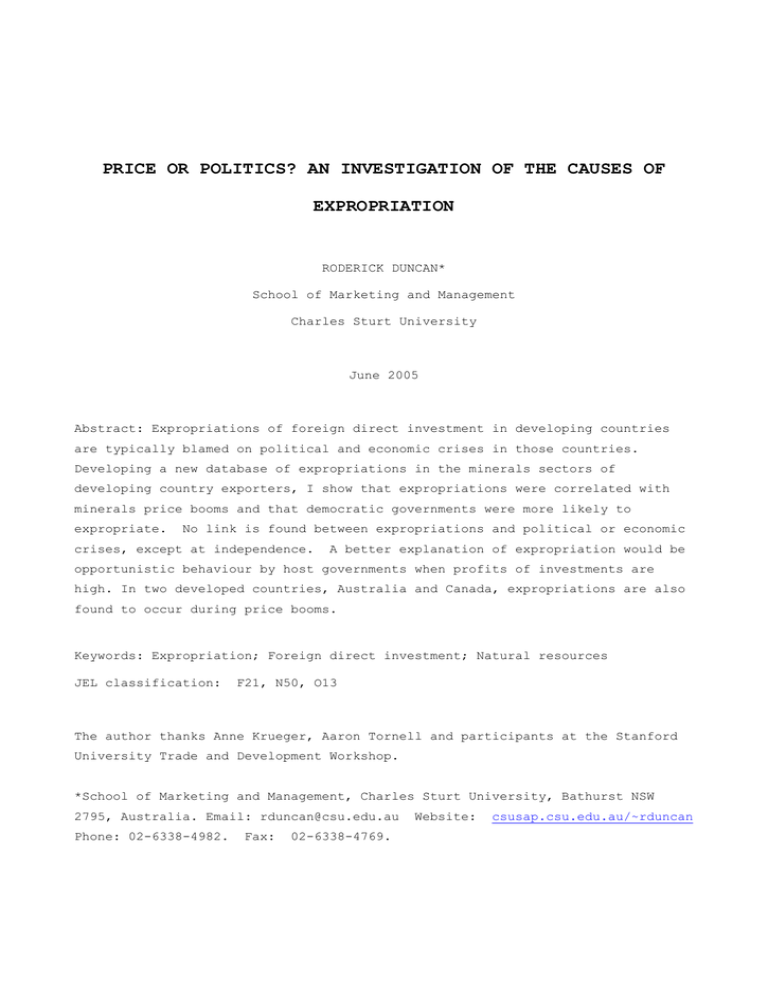
PRICE OR POLITICS? AN INVESTIGATION OF THE CAUSES OF EXPROPRIATION RODERICK DUNCAN* School of Marketing and Management Charles Sturt University June 2005 Abstract: Expropriations of foreign direct investment in developing countries are typically blamed on political and economic crises in those countries. Developing a new database of expropriations in the minerals sectors of developing country exporters, I show that expropriations were correlated with minerals price booms and that democratic governments were more likely to expropriate. No link is found between expropriations and political or economic crises, except at independence. A better explanation of expropriation would be opportunistic behaviour by host governments when profits of investments are high. In two developed countries, Australia and Canada, expropriations are also found to occur during price booms. Keywords: Expropriation; Foreign direct investment; Natural resources JEL classification: F21, N50, O13 The author thanks Anne Krueger, Aaron Tornell and participants at the Stanford University Trade and Development Workshop. *School of Marketing and Management, Charles Sturt University, Bathurst NSW 2795, Australia. Email: rduncan@csu.edu.au Phone: 02-6338-4982. Fax: 02-6338-4769. Website: csusap.csu.edu.au/~rduncan 1. Introduction Between 1967 and 1974 governments in many major copper-exporting developing economies wholly or partially nationalized the foreign-owned copper mines in their countries. These countries included Chile, Peru, Zaire and Zambia. A similar wave of expropriations occurred among the major bauxite-exporting developing countries during 1974 and 1975, including the Dominican Republic, Guinea, Guyana, Jamaica and Surinam. Since the 1980s, there has been no act of expropriation among the same copper and bauxite exporters. Expropriation here means any act by which a government seizes a greater share of an investment project than it was entitled to under the contract with the foreign investor. The meaning of expropriation will be expanded upon below. What caused these sudden episodes of expropriation? occurring in different countries at the same time? expropriations stop occurring? Why were expropriations And why did these This article provides evidence that these expropriations were caused by the high real prices of copper and bauxite and that real output prices are a strong predictor of expropriation across the minerals sectors in both developing and developed countries. Before the late 1960s, real prices of minerals had been on a downward trend for nearly a century. The downward trend had created an environment of pessimism around the production of minerals in developing countries, well illustrated in the words of H. W. Singer (1950, p. 577) at the American Economics Association meeting in 1950: It is a matter of historical fact that ever since the seventies [1870s] the trend of prices has been heavily against sellers of food and raw materials in favour of sellers of manufactured articles. This environment dramatically changed during the minerals price booms of the late 1960s and early-mid 1970s. Price booms created an expectation of higher future prices and imminent worldwide shortages. Paul Ehrlich's Population Bomb appeared in 1968 and forecasted food riots in the United States by the 1980s. The Club of Rome published Limits to Growth in 1972 forecasting minerals shortages in the near future. In the new environment of high and (predicted) rising prices, investment contracts based on export taxes appeared to developing countries as very bad deals, since investment profits rose to a much greater extent than did export tax revenues. Developing countries remedied this situation by expropriating existing investment and by switching to contracts based on profit-sharing. Prain 1975 estimated that copper exports in which the governments held any equity comprised only 2.5 percent of world exports in 1960 but by 1970 this share rose to 43 percent. By 1970, Prain (1975, p. 223) notes: [m]ore than a quarter of the world's copper was being produced by mines totally owned by the government, 12 percent by companies in which the government had a majority interest, and 5 percent in which the government had minority interests. The international environment underwent another change at the end of the 1970s. The minerals sectors entered a price slump that lasted throughout the 1980s and 1990s with a few exceptions. The expected high prices and worldwide shortages never eventuated. In these decades there was no incentive to expropriate for host countries as mine profitability was low. 2. Definition of expropriation In this article expropriation is defined as any act by which a developing economy gains a greater share in the output of an investment than it was entitled to under the original contract between the foreign investor and the developing country government. Expropriation includes: seizure of capital, including mining equipment, reserves of the mine or mining rights (a complete seizure of domestic assets of the foreign company is known as a “nationalization”); compelled sale of mining company shares to the government or domestic nationals; or raising taxes on company revenues or profits where this act was not a part of the original agreement between the foreign investor and the government. The tax increases in the third form of expropriation must be aimed at the investment, rather than economy-wide increases. It is difficult to determine which of these forms of expropriation is more common and how large the total level of expropriations has been, as existing data on expropriations of foreign direct investment is incomplete. Williams (1975) compiled data on nationalizations of foreign investment, only a subset of all expropriations. For the period 1956-1972, Williams found that the value of assets seized by developing country governments was US$10bn (in 1972 values) or nearly 25% of the total stock of foreign direct investment at the end of 1972. The level of total expropriations would obviously be a higher percentage of total foreign investment. 3. Three models of expropriation This section presents three competing models of expropriation. From these models a regression model is developed to test the predictions of each. 3.1 The contract model of expropriation Models of FDI in the economics literature that have considered the possibility of expropriation tend to fall into two camps. The incentive compatible contract papers such as Atkeson (1991), Thomas and Worrall (1994) and more recently Schnitzer (1999, 2002) develop contracts which are expropriation-proof. The random expropriation papers such as Eaton and Gersovitz (1984), Cole and English (1991), Raff (1992) and Veugelers (1993) consider equilibria in which expropriation occurs with a positive probability. The model of Cole and English will be used here. Cole and English developed a model of expropriation of FDI in a country that is subject to stochastic shocks to production. Using the Cole and English notation but replacing their stochastic variable zt with the output price of the FDI Pt, the production function in per capita terms of an FDI in a host country is: yt = Pt f(kt) where yt and kt are the per capita level of output and capital in the FDI. Assuming that host countries maximize the present value of expected utility, Cole and English modelled host country’s expropriation decisions as trading off the present value of extra revenues gained today and in the future from expropriation to the loss of future re-investment and so productivity, assuming that foreign investors would not reinvest after expropriation. Cole and English then defined the expropriation set which is the set of values for Pt for which the expected present value of expropriation exceeds the expected present value of not expropriating the FDI. Assuming a case of a constant relative risk aversion utility, where the utility of present consumption, ct, is: u(ct) = ct1 1 1 Cole and English showed that there are three cases for the expropriation set, corresponding to whether the risk aversion parameter, γ, is greater than, is less than one or is equal to one. In the case where γ is less than one, the host country will expropriate when output prices are high. expropriation. They call this the “opportunistic” explanation of This was also the prediction of the model in Section VI of Eaton and Gersovitz (1984) and in Raff (1992). In the case where γ is greater than one, the host country will expropriate when output prices are low. English call this the “desperation” explanation of expropriation. Cole and In the case where γ is equal to one, utility is logarithmic, and expropriation either always occurs or never occurs. The third case is not considered as expropriation of FDI seems to occur only occasionally. A probabilistic interpretation of the two cases in Cole and English (“the contract model”) is that: opportunistic explanation: the probability of an expropriation increases in years in which the real price of the output mineral is high (“boom years”); or desperation explanation: the probability of expropriation increases in years in which the real price of the output mineral is low (“bust years”). 3.2 The political revolution model of expropriation This model of expropriations states that expropriations follow on from and are a result of political revolutions in a country, typically a former colony. Kobrin (1980a, p. 74) labelled these expropriations “mass expropriations” and described them as “typically associated with sweeping and violent upheavals, which transformed the basic governmental structure and political-economic ideologies of the nation involved.” The political upheavals that led to this change in the balance of power between the colony and its Western master were radical, and it was these changes that were widely believed to be the principal cause of expropriation. A survey of executives of 233 U.S. companies in the 1970s gave the most commonly cited explanation for government expropriation to be, from Basche (1979, p. 8), “[p]olitical change involving not only a change of political leaders and government personnel- but also, more fundamentally, a change in political and social ideology.” If this explanation were the true model of expropriations, one would expect that expropriations occur at the same time or shortly after radical changes in political and social structures in a developing country. In probabilistic terms this model yields the hypothesis that: the probability of expropriation increases if there was a political crisis involving a large change in the political structure of that country in that year. 3.3 The political risk model of expropriation A literature exists, mainly within business school journals, which seeks to explain expropriatory actions by governments on the basis of the macroeconomic and political environments in those countries. This theory draws from both politics and international business and attempts to calculate what it terms “political risk” to international business. A review of this literature is contained in Kobrin (1979). In the political risk literature expropriatory behaviour is driven by political pressure on the domestic country government. However, the political risk model proceeds further than the political revolution by investigating the forces behind political pressures to expropriate. The explanation behind this model is that under criticism from either opposing political forces, the media and/or popular forces, host governments expropriate foreign investments. An expropriation could have a symbolic value, using foreign investors as a scapegoat for domestic troubles, or an expropriation might have a real effect, by raising government tax revenues or reducing the balance of payments. One such source of political pressure might be poor economic performance within the domestic economy. Another source of political pressure might be the balance of payments. In probabilistic terms this model yields the hypotheses that: the probability of expropriation increases if domestic real GDP growth was low that year; and the probability of expropriation increases/decreases if the domestic balance of payments as a percentage of GDP was worse that year. 3.4 Review of the empirical literature The empirical literature on expropriation of foreign investment is not well integrated into the theoretical literature. This failure stems from the fact that the empirical literature comes out of work in the political revolution and political risk areas which have no formal model at their foundations. The existing empirical literature is then a set of regressions where the choice of variables included is based on whether a plausible argument can be made that the variables might be expected to influence expropriations. The political revolution model of expropriation has not been truly tested, however Jones (1980) found some support, while Jodice (1980) did not, for a relationship between domestic unrest and expropriation. The political risk model has been directly tested with Knudsen (1974), Jones (1984) and Picht and Stüven (1981) finding a negative correlation between real GDP growth and the probability of expropriation, however Jodice and Picht and Stüven draw opposing signs for estimates of the relationship between balance of payments difficulties and expropriations. The results of the current literature, on the whole, have been weak. 4. The data and the regression model In order to test these three models of expropriation, a database of government expropriations for seven major minerals from 1960 to 2002 was constructed. This database is available on the author’s website. The minerals selected were: bauxite, copper, lead, nickel, silver, tin and zinc. These minerals were selected because they are important minerals for developing countries' export revenues and for developed countries' industry. The countries in the sample are the eight largest developing country exporters for the period 1965-1975 for each of these minerals. (Formerly) Communist countries were excluded as these countries were not sufficiently linked to the world minerals markets over this period. Any seizure of assets, demand for equity stake or increase in taxes by the host government that was not a condition of the original contract was considered to be an expropriation. Information on host government activities in the minerals sector was gained from various issues of Minerals Yearbook. An observation in this database is whether an expropriation took place in a foreign-financed project for that mineral, in that country, in that year. Out of the total of 2408 observations of commodity-country-years, there were only 50 cases of expropriation. Out of these 50 cases, 20 were acts of seizure of company assets, 12 were uncontracted increases in the equity share held by the host government and 18 were uncontracted increases in taxes on the mining companies. Two events which were government-mandated increases in workers’ wages were classified as tax increases, as these effectively raised company costs much as a new tax. Separate regressions were run for each form of expropriation, but the results were not qualitatively different, so only the pooled regressions are presented. Of the 27 countries included in the database, expropriations occurred at least once in 18 of the countries. [Put Table 1 here.] Table 1 sets out these acts of expropriation by mineral and by decade, as well as average real prices of the seven minerals. Real prices of minerals were obtained from the United States Geological Survey “Historical Statistics” website. These real mineral prices were then normalized to have a mean of one over the period 1960-2002. real price. All references to “price” will be to the normalized For the purposes of testing the contract model, a definition of boom years and bust years is needed- years when a real mineral price was significantly above or significantly below its long-term average price. None of the empirical results depended on the critical value chosen, so a value of 66% and 150% was arbitrarily used as the definition of a bust and boom year respectively. Three different measures of “political crisis” were constructed. Out of the 27 developing countries in the database, 15 became independent after 1955. A dummy variable called “Newly Independent” is used to indicate whether that country became independent recently. Often gaining independence can be a lengthy process, so an immediate correlation between independence and expropriation might not be expected. In this dataset, the largest level of economic and statistical significance was found to be within 5 years of gaining independence. A second measure of political crisis is a large change in the institutions of the country. A dummy variable called “Constitutional Crisis” is used to indicate that change. The data on constitutional crises is derived from the Polity IV database described in Marshall and Jaggers (2001). The Polity IV database contains indices for the level of democracy and autocracy of the political institutions for each country-year. A combined measure for each country-year is derived by subtracting the autocracy score from the democracy score to generate a scale of -10 (least democratic) to 10 (most democratic) for the country's institutions in that year. This index is labelled the “Democracy”. The Democracy index coverage does not include the countries of New Caledonia and Suriname, nor does it include countries in years in which those countries were colonies. A constitutional crisis in any country-year is indicated by a change in this combined index of three points or more from that of the previous year, according to Marshall and Jaggers. Smaller thresholds for crises and lagged crises were examined but did not significantly affect the analysis. A third measure of political crisis is whether there was a change in the chief executive in that country in that year. A dummy variable called “Change in Government” is used to indicate a change in the chief executive. Data on changes in executives was obtained from Beck et al (2001) and from Banks et al (2003) to narrow the change down to a particular year. [Put Table 2 here.] Macroeconomic data on the real growth of GDP and the balance of payments as a percentage of GDP are taken from the United Nations Statistics Division “National Accounts” website and from the International Monetary Fund’s International Financial Statistics respectively. Growth of real GDP is reported in percent. The balance of payments is normalized by presenting it as a percentage of nominal GDP. Sample statistics for the data are set out in Table 2. A regression model can be based around the three models of expropriation. The contract model would suggest that expropriation occurs when the real output price of the project either is greater than or less than some critical value, ∆, which includes any punishment imposed on the country due to the expropriation. Assume this equation is a linear function of price, an expropriation is observed in industry j and country i in year t if and only if αijt + βijtpjt > ∆ijt where βijt will be positive in the opportunistic explanation of expropriation and negative in the desperation explanation. To increase the power of the regressions, it is further assumed that the αijt's and βijt's are the same across countries and industries and time. ∆ijt includes variables that could otherwise influence expropriation, such as the growth rate of real GDP or the occurrence of political crises. Suppose one can linearize ∆, so that ∆ijt = γ δijt then expropriation is observed when α + β pijt - γ δijt + εijt > 0 where εijt is assumed to have a normal distribution with mean zero and variance one. It is this equation which is estimated using probit analysis. This is called the “Expropriation Equation”. 5. Results from the data 5.1 Evidence from summary statistics Table 3 presents some sample statistics of the expropriation variable. Using the definition of boom year discussed in the previous section, the contract model predicts that the conditional probability of expropriation in a boom year is higher than the conditional probability of expropriation in a non-boom year. Only lead and zinc does not follow this pattern. [Put Table 3 here.] From all seven minerals a clear pattern arises. Although boom years constituted only 7 percent of the total years observed, 34 percent of the expropriations occurred in these years. Overall a default was seven times more likely to occur in a boom year than it was in a non-boom year. An F-test that the probabilities of expropriation are the same inside a boom year as a non-boom year gives a test statistic of F(1, 2406) = 58.8. This hypothesis that there is no relationship between minerals price booms and expropriation is rejected at far below the 1 percent confidence level. The dataset sample statistics do support the opportunistic interpretation of expropriation. The desperation explanation suggested that there might be a link between low prices for minerals and expropriations. For various measures of a “bust” year at 50%, 66% or 75% of average real prices, the probability of expropriation is far lower for bust years than for non-bust years. The desperation interpretation of expropriation is not pursued any further, as the dataset does not support it. If the political revolution model were correct, the probability of expropriation should be higher in years of political crisis. No statistically significant effect was found within one or three years after independence, however the probability of expropriation is statistically different at the 1% level within five years of gaining independence, with a test statistic of F(1, 2406) = 12.9. For a constitutional change and a change in executive government, the probability of expropriation coinciding with years of crisis is not statistically significant at any level, with test statistics of F(1, 2046) = 0.04 and 0.34 respectively. This finding is robust for several different time lags. 5.2 Results from probit regressions Tables 4 and 5 present the results of probit regressions on the Expropriation Equation set up in section 4. The dependent variable is the incidence of expropriation in a particular mineral, country and year. [Put Table 4 here.] Table 4 tests whether the results are robust to panel data correction methods. The first column of Table 4 presents the results for a standard probit regression. Panel data corrections for probit models are problematic. No consistent fixed effects probit estimation method exists (see Baltagi, page 181), so country specific effects are corrected in the second regression in Table 4 through dummying each country individually. The third column presents the results from a random effects probit regression. The results of the regressions for price booms are robust across the panel data corrections. No correlation is found between years of constitutional change or of executive change and expropriation, while there is some evidence of a positive effect between gaining independence within five years and expropriation. If the individual features of each country are corrected with a dummy variable as in Regression 2, the Newly Independent variable is found to be statistically insignificant, while a positive and statistically significant effect is found for the Balance of Payments. Due to the problems with the fixed effects estimation and with interpretation of the random effects model, Regression 1 is chosen as the reference model, but the Balance of Payments variable is retained as it does have explanatory in one form of the regression. [Put Table 5 here.] One potential problem with the Newly Independent variable is that 11 of the countries in the sample became independent in the 1960s and 1970s, and so the issue of independence may become confused with world-wide factors special to those decades. To try to capture the effects of world-wide factors in the 1960s and 19702, I introduce a dummy for those decades. Table 5 explores the form of Regression 1 with several variants. Regression 4 in Table 5 introduces decade dummies for the 1960s and 1970s and tests for the effect of democracy. An interaction variable between real minerals price and the level of democracy of a country is used in Regression 5. In Regression 6, the dataset is restricted to only those countries which were independent before World War 2, in order to determine whether the price boom effect is unrelated to questions of independence. The coefficient of price booms and the decade effect of 1960s and 1970s are positive, statistically significant and robust across the specifications. Adding the democracy variables reduced the explanatory power of the independence variable. Achieving independence up to 5 years prior did have a positive effect, but it was only statistically significant at the 10% level once the interaction effects of democracy are taken into account and was not significant if the democracy variable is included. The coefficient of the balance of payments does not have a statistically significant effect across any of the variants. The coefficient of democracy and the coefficient of interaction of democracy and real price are positive and statistically significant at the 1% level. All of the results are robust to the restricted dataset of those countries that were independent before World War 2. 5.3 The significance of price and contract form The probit regressions explored the relationship between the output price of a foreign direct investment and the behaviour of the developing country government in which the investment operates. This revealed a strong positive relationship between the price and the probability of expropriation by the government. As the period of the 1960s and the 1970s saw many more price booms than the period of the 1980s and 1990s, this can partly explain why there were so many more expropriations during the early period. The lone recorded expropriation in the 1980s and 1990s occurred in the nickel sector in the Dominican Republic in 198788 when the real price of nickel almost tripled the previous year's average. [Insert Table 6 here.] There is strong support for the opportunistic explanation of expropriation in this dataset. Comparing the predicted probabilities of expropriation from Regression 5 in Table 6, price booms had a large effect on the probability of expropriation in the early period and a lesser impact in the later period. There has also been a distinct change in the behaviour of developing country governments from the early period, as revealed by the large and significant coefficients on the decade dummy. Even taking into account the lower prices in the late period, governments are now less likely to expropriate than in the early period. Given a tendency to expropriate in times of high prices or profitability, the most stable form of FDI contract may then be a pure “resource rent tax” contract similar to that proposed by Garnaut and Clunies Ross (1975). Under this contract government tax revenues are derived solely from a profits tax where the rate of tax of profits may even be progressive in the level of profits. By granting a large portion of the revenue stream of the project to the government in the good states, this contract lessens the incentive to expropriate. The cost is that the developing country government bears a large part of the price and output risk of the contract, which the government may have problems hedging against. Extreme cases of these new contracts are the “service contracts” some minerals companies have signed with developing countries. Under these contracts mining companies explore, develop and even produce from an ore body for a flat fee from the host government. The host government owns all the capital in the project and bears all of the price and output risk of the project. These projects bear no risk of expropriation. 5.4 The significance of politics and political crises The political revolution model of expropriation is strongly rejected by this data, except to the extent that gaining independence is found to have had a significant effect. Expropriations do not necessarily coincide with or follow from significant political changes or from periods of internal war or civil strife. Political language of “sovereignty” and “revolution” may thus just be cover for actions motivated by more mundane considerations. The results of the regressions in Table 4 suggested that the fact of gaining independence was a significant contributor to expropriation. However, in Table 5, once account is taken of the world-wide factors in the 1960s and 1970s and account is taken of the contribution of democracy to expropriation, the economic and statistical significance of independence falls away. The importance of the democratic nature of the country's institutions stands in stark contrast to the irrelevance of constitutional crises within those institutions. The more democratic the institutions of the country, the more likely it was to expropriate, as shown in Table 6. Table 5 suggests that this relationship between expropriations and democracy comes through the interaction between price and democracy. The more democratic the political institutions of the host country, the more sensitive to price are the decision to expropriate. Yet the data on political change did not reveal any link between change in executive and expropriation, thus expropriation is not caused by turnover of political power. This fact supports the idea that it is the higher potential for turnover among political interest groups in a democracy that leads to a higher discount rate among those groups and thus leads to a higher tendency to expropriate in those countries, rather than the actual turnovers of power. A different explanation might be that contained in Lane and Tornell (1998). One interpretation of their model is that interest groups take turns ruling a country. These interest groups all derive benefits from a common resource, but the party in power has the option of taking the whole resource for itself. If the interest group currently in power does not trust future interest groups not to expropriate when they come into power, the current interest group will expropriate now rather than wait and let a future interest group expropriate. Democracies in this case would be very prone to expropriate. These results indicate a negative relationship between political freedom and security of property rights, at least for foreign investors. Barro and Lee (1994) found a positive relationship between political freedom and growth of real GDP for a group of 116 countries from 1965-1985. The traditional explanation for this result would be that democracy restricts the actions of government and thus promotes property rights. Bohn and Deacon (2000) used this argument when they discovered that democracy and aggregate investment were positively correlated. However the results in this article suggest that political freedom and property rights may not be positively related. Democracy may lead to less stable property rights, particularly for foreign investors. 5.5 The (in)significance of macroeconomic factors The macroeconomic variables from the political risk model appear to have little predictive power in this data set. Neither real GDP growth nor balance of payments have a statistically significant relationship to expropriation at even the 10 percent level of confidence, except in the problematic fixed effect probit regression in Table 4. There is no support for the political risk model of expropriation in this dataset. 6. Are developed countries immune to this pressure? No features of the contract or political risk models are predicated on the host country being a developing economy. The political pressures which were mentioned as a possible explanation for expropriations are not particular to developing countries alone. In fact the democratic nature of political institutions in most developed countries may make them more prone to expropriation if the link between democracy and expropriation uncovered in the previous section is correct. However, past empirical studies, including all of the articles summarized in section 3, consider only expropriations which occurred in developing countries. Is this focus justified? Australia and Canada are two developed economies which are also large minerals exporters. Searching through various issues of the Minerals Yearbook in the same seven minerals extraction sectors as were examined in the developing economies, 11 acts of expropriation either by state or federal governments in Australia and Canada were found between 1960 and 1996. The conditional probability of expropriation given a boom year is 9.3 percent, while it is 1.33 percent given a non-boom year. An F-test for the equality of the probabilities of expropriation for boom years and non-boom years is F(1,592) = 16.0 and so rejected at 1% significance. Australia and Canada were more likely to expropriate the value of foreign direct investments during periods of high real prices for the output of the projects. This suggests that developed countries do not behave very differently from developing countries in this respect. An interesting point to note is the role that the federal structure of the Australian and Canadian constitutions may have played in the expropriations. Of the eleven expropriations reported, four were by state or provincial governments. In one case, that of the Canadian copper industry, the Canadian federal government reacted to a rise in provincial taxes by introducing a limited federal tax write-off of provincial taxes. The federal nature of the Australian and Canadian constitutions grants much wider powers to state governments than does a constitution styled on that of the United States. These broader powers of taxation mean that in the Australian and Canadian case there are two independent governments which can expropriate the value of the same foreign investment. The foreign investment is then a common resource of the two governments, which may lead to the same “voracity” effect as was described in the previous section. 7. Conclusion Some answers for the questions posed in the Introduction can now be provided. The waves of expropriations seen in the developed world in the 1960s and 1970s were a result of the high real prices for the minerals at the time, as well as to some extent the wave of independence across developing countries. The combination of high real prices and the low profit-sharing of the contracts at the time gave the host governments large incentives to expropriate. Developed countries are no different from developing countries in this regard, as Australia and Canada had a similar history of expropriation during times of high prices. The standard explanation for expropriation- that of political or economic crises within the host country- is incorrect for expropriations within the minerals sector. However politics is an important explanatory factor in expropriation as democracies were observed to be far more prone to expropriation than are dictatorships. Facing uncertainty over future minerals prices, the best defence for foreign investors against expropriation is to maintain a large domestic ownership/profit share in the project. Such contracts lessen the gap between the value of a firm in expropriation and the tax revenues of the domestic government from the project, and thus the temptation to expropriate. Returning to an era of depressed minerals prices and little expectation of future price rises in the 1980s and 1990s, the decisions by those developing countries that expropriated in the past now look terrible. Contracts based on profit-sharing in an era of low profits generated little tax revenue, and nationally-owned mines did not generate revenues needed for reinvestment. This new depressed environment has generated a relatively recent response by developing countries to divest themselves of minerals assets. The question remains however about the behaviour of developing country governments if the world moves into another period of rising minerals prices in the future. The recent shift to democratic political institutions in many developing countries may cause problems in the future if minerals prices begin to rise. REFERENCES Atkeson, A. (1991). International lending with moral hazard and risk of repudiation, Econometrica 59(4), 1069-1089. Baltagi, B.H. (1995). Econometric Analysis of Panel Data. John Wiley and Sons, New York. Banks, A., Muller, T. and Overstreet, W. (2003). Political Handbook of the World 2000-2002. CSA Publications, Binghampton. Barro, R.J. and Lee, J.-W. (1994). Sources of economic growth, CarnegieRochester Conference Series on Public Policy 40, 1-46. Basche, J.R. (1979). Nationalization: The experience of U.S. companies in the 1970's, Information Bulletin, No. 62, The Conference Board. Beck, T. et al. (2001). New tools in comparative political economy: The Database of Political Institutions, World Bank Economic Review 15(1), 165-176. Bohn, H. and Deaton, R. T. (2000) Ownership risk, investment and the use of natural resources, American Economic Review 90(3), 526-549. Cole, H.L. and English, W.B. (1991). Expropriation and direct investment, Journal of International Economics 30, 201-227. Eaton, J. and Gersovitz, M. (1984). A theory of expropriation and deviations from perfect capital mobility, The Economic Journal 94, 16-40. Garnaut, R. and Clunies Ross, A. (1975). Uncertainty, risk aversion and the taxing of natural resource projects, The Economic Journal 85, 272-287. International Monetary Fund. (various years). International Financial Statistics. International Monetary Fund, Washington. Jodice, D.A. (1980). Sources of change in Third World regimes for foreign direct investment, 1968-1976, International Organization 34, 177-206. Jones, R.J. Jr. (1980). A model for predicting expropriation in Latin America applied to Jamaica, Columbia Journal of World Business Spring, 74-80. Jones, R.J. Jr. (1984). Empirical models of political risk in U.S. oil production in Venezuela, Journal of International Business Studies 15, 81-95. Knudsen, H. (1974). Explaining the national propensity to expropriate: An ecological approach, Journal of International Business Studies 5, 51-71. Kobrin, S.J. (1979). Political risk: A review and reconsideration, Journal of International Business Studies 10(1), 67-80. Kobrin, S.J. (1980a). Foreign enterprise and forced divestment in LDCs, International Organization 34(1), 65-88. Kobrin, S.J. (1980b). The assessment and evaluation of noneconomic environments by American firms: A preliminary report, Journal of International Business Studies 11(1), 32-47. Marshall, M. and Jaggers, G. (2001). Polity IV. Integrated Network for Societal Conflict Research (INSCR) Program, Center for International Development and Conflict Management, University of Maryland. Picht, H. and Stüven, V. (1991). Expropriation of foreign direct investments: Empirical evidence and implications for the debt crisis, Public Choice 69, 1938. Prain, R. (1975). Copper: The Anatomy of an Industry. Mining Journal Books, London. Raff, H. (1992). A model of expropriation with asymmetric information, Journal of International Economics 33, 245-265. Schnitzer, M. (1999). Expropriation and control rights: A dynamic model of foreign direct investment, International Journal of Industrial Organization 17, 1113-1137. Schnitzer, M. (2002). Debt v. foreign direct investment: The impact of sovereign risk on the structure of international capital flows, Economica 69, 41-67. Singer, H.W. (1950). The distribution of gains between investing and borrowing countries, American Economic Review: Papers and Proceedings 40(2), 473-485. Thomas, J. and Worrall, T. (1994). Foreign direct investment and the risk of expropriation, Review of Economic Studies 61, 81-108. Tornell, A. and Lane, P.R. (1999). The voracity effect, The American Economic Review 89(1), 22-46. United Nations Statistics Division. (2005). National Accounts Main Aggregates Database. United Nations. Available from URL: http://unstats.un.org/unsd/snaama/. U.S. Bureau of Mines. (various years). Minerals Yearbook. US Department of Interior, USGPO, Washington. U.S. Geological Survey. (2005). Historical statistics for mineral and material commodities in the United States, Open-File Report 01-006, U.S. Department of the Interior. Available from URL: http://minerals.usgs.gov/minerals/pubs/of01- 006/. Veugelers, R. (1993). Reputation as a mechanism alleviating opportunistic host government behavior against MNEs, Journal of Industrial Economics 41(1), 1-17. Williams, M. L. (1975). The extent and significance of the nationalization of foreign-owned assets in developing countries, 1956-1974, Oxford Economic Papers 27, 260-273. Table 1: Number of Expropriations and Price Booms in Selected Country/Industries by Mineral and by Decade (Number of expropriations) 1960 - 1970 - 1980 - 1990 1969 1979 1989 2002 All Years Bauxite 1 15 0 0 16 Copper 5 6 0 0 11 Lead 1 1 0 0 2 Mineral Nickel 0 0 1 0 1 Silver 1 2 0 0 3 Tin 2 11 0 0 13 Zinc 2 2 0 0 4 12 37 1 0 50 1.03 1.32 1.09 0.67 1 All Minerals Ave. Minerals Price Table 2: Sample Statistics Mean Overall Std. Dev. Min. Between Country Number of Max. Std. Dev. Observ's Expropriation 0.021 0.14 0 1 0.03 2408 Constitutional Crisis 0.12 0.32 0 1 0.09 2211 Change in Government 0.17 0.38 0 1 0.1 2408 Growth of Real GDP 3.65 5.56 -48.8 67.9 2.01 2292 Balance of Payments -3.26 5.74 -37.1 37.6 3.48 1977 Democracy Index -0.63 6.79 5.08 2104 -9 10 Table 3: Probability of an Act of Expropriation in Selected Country/Industries by Mineral (Percent of observations in which an expropriation occurred) Unconditional In boom year Not in boom year Bauxite 4.7 50.0 3.6 Copper 3.2 25.0 2.1 Lead 0.6 0.0 0.6 Nickel 0.3 6.3 0.0 Silver 0.9 2.5 0.7 Tin 3.8 14.5 2.0 Zinc 1.2 0.0 1.3 All Minerals 2.1 10.1 1.5 Table 4: Results of the Probit Regressions for the Expropriation Equation (Dependent variable is the probability of expropriation) Regression: (1) (2) (3) Standard Unconditional Random Probit Fixed Effects Effects Panel Probit Panel Probit Price Boom Dummy 0.992*** (0.165) 0.94*** (0.252) 0.067 (0.249) -0.066 (0.201) -0.004 (0.012) 0.008 (0.011) 1.18*** (0.199) 0.389 (0.357) 0.033 (0.274) -0.002 (0.229) 0.012 (0.017) 0.027** (0.013) 1.09*** (0.184) 0.626* (0.32) 0.072 (0.262) -0.022 (0.217) 0.004 (0.014) 0.018 (0.013) -2.25 1906 ---0.114 -168.7 ---1115 14 0.199 -135.5 -2.4 1906 24 ----161 Newly Independent Constitutional Crisis Change in Government Growth of Real GDP Balance of Payments Constant Observations Groups Pseudo R2 Log Likelihood Note: ***, **, and * denote statistical significance at the 1%, 5%, and 10% level respectively. Standard errors are in parentheses. Table 5: Probit Model with Interaction of Real Price and Democracy Variables (Dependent variable is the probability of expropriation) Regression: (4) Standard Probit (5) Standard Probit (6) Standard Probit Price Boom 0.99*** (0.19) 1.68*** (0.37) 0.45 (0.27) 0.011 (0.012) 0.048*** (0.01) --- 1.07*** (0.20) 1.74*** (0.41) 0.46* (0.27) 0.01 (0.013) --- 1.00*** -0.27 1.42*** (0.45) --0 (0.036) --- 0.039*** (0.01) 0.033* (0.017) -3.58 1892 0.253 -136.1 -3.31 1075 0.18 -68.2 Decade: 1960s or 1970s Newly Independent Balance of Payments Democracy Democracy and Price Interaction Constant Observations Pseudo R2 Log Likelihood -3.52 1895 0.246 -137.5 Note: ***, **, and * denote statistical significance at the 1%, 5%, and 10% level respectively. Standard errors are in parentheses. Table 6: Predicted Probability of Expropriation Using the Estimated Coefficients from the Expropriation Model (Predicted Probability in Percent) Using the estimated coefficients from Regression (1) Price Boom No Yes Newly Independent No Yes 1.2 9.5 10.4 37.5 Using the estimated coefficients from Regression (5) Not Newly Independent Decade: 1960s and 1970s Democracy Index Price Boom -10 0 10 No 1.3 3.3 7.4 Yes 6.1 22.1 50.4 Decade: 1980s, 1990s and 2000-2002 Democracy Index Price Boom -10 0 10 No 0.0 0.0 0.1 Yes 0.1 0.6 4.2 Newly Independent Decade: 1960s and 1970s Democracy Index Price Boom -10 0 10 No 3.8 8.4 16.1 Yes 13.8 37.8 68.1 Decade: 1980s, 1990s and 2000-2002 Democracy Index Price Boom -10 0 10 No 0.0 0.1 0.3 Yes 0.2 2.0 10.2 Note: All other variables held at their period averages. Assumed value of real price during boom years is 2 and during non-boom years is 1.
